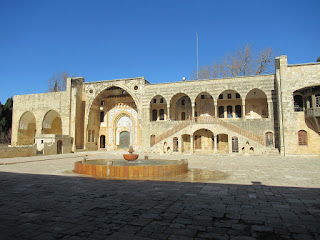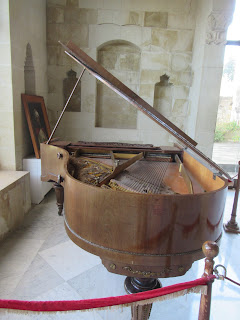My trip into the Chouf Mountains was spent in conversation with my very knowledgeable driver/guide Rabih from Lebanon Tours & Travel. Our lively discussions covered Lebanese history, politics, culture, Islam and women's rights, and while Rabih had certain conspiracy proclivities with which I didn't agree, our talks did make for an enormously interesting day.
First stop was the so-so Christian Maronite town of Deir Al-Qamar, where the ancient Phoenicians worshipped the moon. More "recently", it was the capital of Mount Lebanon in 1590 (remember, 'way before it became a country in 1920). Dany Choun Square is in the center -- or, rather,
is the center of town. There really wasn't that much to see:
 |
The building behind the sign is the Silk Khan, built at the end of the 16th century.
Where once there was a thriving silk trade, today there are only a couple of souvenir shops. |
 |
Part of the khan (traditional architectural style) is now the local French Cultural Center, which offers French programs and language lessons. At the far right (east) end of the building is the former Place of Fakhreddine, now a wax museum.
I didn't bother. |
 |
Youssef Chehab Serail ("serail" meaning a government post or headquarters) is the municipal building and dates from the 18th century and continues to serve that function. However, in 1860, Emir Yousseff lured area Christians to this place, slaughtered 1200 of them (correct, 12-hundred!), and then tossed their bodies out into the courtyard.
History's whimsical vagaries never ceasing...a quick stop in front of the Disneyland-like "Moussa Castle" between Deir al-Qamar and the next stop -- the day's true pièce de résistance!
 |
The well-known story about this contemporary castle is that it was created by a man who was ridiculed as a boy for wanting to live in a castle, so when he grew up he designed and built one. But what's truly amazing about this (overpriced) tourist attraction, finished in 2005, is that every one of the stones with images had been hand-carved by Moussa Abdel Karim a-Maamari himself.
And now, saving the best of the day for last -- Beittedine Palace ("House of Faith"). Built over a 30-year period on the site of a former Druze hermitage by Italian architects and skilled Syrian artisans, it was started in 1788 and finished in 1840. It was the emir's home until 1840 when the British forced him into exile in Turkey, but it remains a "perk" for any current (Maronite Christian) Lebanese president to use whenever he wants. Sort of his vacation home.
I simply couldn't stop taking pictures (especially of the mosaics and carved cedar doors, windows and ceilings!), so without any more words, here they are:
Whew! Amaaaazing place, right?!
***
Next and final chapter: Qadisha Valley (St. Anthony Monastery [Arab world's first printing press], The Cedars, Bcharré [Birth and resting place of poet/painter/philosopher Khalil Gibran])
|
|











































Comments
Post a Comment